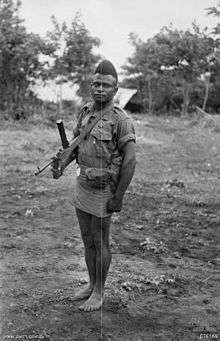Papuan Infantry Battalion
| Papuan Infantry Battalion | |
|---|---|
|
Sergeant Bengari MM of A Company, 5 August 1944 | |
| Active | 1940–46 |
| Country |
|
| Allegiance | Allied |
| Branch | Army |
| Type | Infantry |
| Size | Battalion |
| Colours | Red and Green |
| Battle honours | South West Pacific 1942–45, Kokoda Trail, Kokoda-Deniki, Nassau Bay, Tambu Bay, Finschhafen, Scarlet Beach, Liberation of Australian New Guinea, Sio-Sepik River, Kaboibus-Kiarivu and Bonis-Porton |
| Disbanded | August 1946 |
| Insignia | |
| Unit Colour Patch |
|
The Papuan Infantry Battalion (PIB) was an infantry battalion of the Australian Army that was raised for service during World War II. Formed in early 1940, the battalion was recruited from the territory of Papua and was intended to be used to defend the territory in the event of a Japanese invasion. Commanded by European officers and non-commissioned officers, following the outbreak of the Pacific War, the PIB served in a number of campaigns against the Japanese until the end of the war. Together with several New Guinea infantry battalions, the PIB was formed into the Pacific Islands Regiment in late 1944. It was disbanded in mid-1946.
History
The Papuan Infantry Battalion was formed on 27 May 1940 in the territory of Papua, during World War II, in order to fight the Japanese.[1] The unit was slow in forming, with its first members arriving in March 1941.[1] By 1942 it consisted of only three companies and were all understrength and poorly equipped. The PIB was soon sent forward in June 1942 to patrol the northern coast of Papua and were dispersed over a wide area, led by Australian officers and NCOs. The small parties were the first to make contact with the Imperial Japanese forces upon landing in Papua. The battalion would ultimately serve in many of the Allied campaigns in New Guinea, with its soldiers becoming noted for their ferocity and tenacity against the Japanese during the Kokoda Trail campaign, Salamaua-Lae campaign, Ramu Valley-Finisterre Range campaign, Bougainville campaign and Aitape-Wewak campaign.[2]
The battalion had an establishment of about 77 Europeans and 550 native soldiers.[3] The PIB, along with the 1st and 2nd New Guinea Infantry Battalions, were amalgamated to form the Pacific Islands Regiment in November 1944. The 3rd and 4th New Guinea Infantry Battalions joined the regiment in 1945, although 4NGIB was soon disbanded, whilst the 5th New Guinea Infantry Battalion—although authorised—was never raised.[4] The battalion was disbanded in August 1946.[1] The battalion's casualties during the war amounted to 32 killed, 15 missing, 42 died, and 25 wounded.[5] Personnel from the PIB received the following decorations: one Distinguished Service Order, three Military Crosses, one George Medal, three Distinguished Conduct Medals, 15 Military Medals and three Mentions in Despatches.[6]
Battle honours
- World War II: South West Pacific 1942–45, Kokoda Trail, Kokoda-Deniki, Nassau Bay, Tambu Bay, Finschhafen, Scarlet Beach, Liberation of Australian New Guinea, Sio–Sepik River, Kaboibus–Kiarivu and Bonis–Porton.[7]
Commanding officers
The following officers commanded the PIB:[2]
- Major L. Logan (1940–42)
- Major W.T. Watson (1942–44)
- Lieutenant Colonel E.A.F Stanfield (1944)
- Lieutenant Colonel S. Elliott-Smith (1944–45)
Notes
- 1 2 3 Sinclair 1990, p. 296.
- 1 2 "Pacific Islands Regiment". Australian War Memorial. Retrieved 12 September 2014.
- ↑ Dennis et al. 1995, p. 449.
- ↑ Sinclair 1990, p. 273.
- ↑ Byrnes 1989, p. 269.
- ↑ Figures for awards to PIR are difficult to accurately determine as most sources are incomplete, these figures are from Sinclair 1990, pp. 228–246. Neither Sinclair nor Byrnes seem to include complete lists.
- ↑ The battle honours listed above are those awarded to the PIR in 1961 as listed in Byrnes 1989, p. ii.
References
- Byrnes, G.M. (1989). Green Shadows: A War History of the Papuan Infantry Battalion, 1 New Guinea Infantry Battalion, 2 New Guinea Infantry Battalion, 3 New Guinea Infantry Battalion. Newmarket: G.M. Byrnes. ISBN 0-7316-6716-6.
- Dennis, Peter; Grey, Jeffrey; Morris, Ewan; Prior, Robin (1995). The Oxford Companion to Australian Military History (First ed.). Melbourne: Oxford University Press. ISBN 0-19-553227-9.
- Sinclair, James (1990). To Find a Path: The Life and Times of the Royal Pacific Islands Regiment: Volume I — Yesterday's Heroes 1885–1950. Brisbane: Boolarong Publications. ISBN 0-7316-9120-2.
- Sinclair, James (1992). To Find a Path: The Papua New Guinea Defence Force & The Australians to Independence: Volume II - Keeping the Peace 1950–1975. Brisbane: Boolarong Publications. ISBN 1-86333-062-3.
